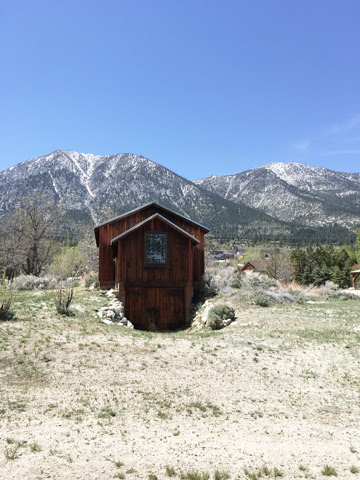It was 1855 or thereabouts when Moses Job, an enterprising trader from Virginia, opened a small store at what would eventually become Sheridan, Nevada.
Job’s trading post nestled right beside the Emigrant Trail, a convenient spot for both passing emigrants and nearby settlers. Soon, a small cluster of homes and businesses sprang up beside Job’s early store.

And voila, the town of Sheridan was born – named (they say) after Union Army General Philip Henry Sheridan.
Moses Job sold his store to J.W. Haines and I.W. Duncan in 1861 – along with 800 acres of land including the early townsite. And, as the 1860s rolled by, the settlement at Sheridan slowly expanded.
The Sheridan Hotel (as we saw in our earlier story) first opened its doors in the early 1860s – yet another convenience for travelers on the dusty Emigrant Trail. Soon, Sheridan could boast two hotels – along with (no surprise) two saloons.
The Sheridan store became a surprisingly large, well-stocked operation; in 1865, for example, some 9,000 pounds of merchandise were shipped in for winter supplies. A small branch post office inside the store opened that same year, with James Billis as Sheridan’s first postmaster. For a short time the tiny town even boasted its own newspaper, though editor Will Lee “failed to keep the wolf from the door,” and by 1881 the paper had folded.
The first inhabitants near Sheridan, of course, were the Washoe people, and a few Native Americans continued to reside nearby even as the town grew. Sadly, little history of the Washoe presence at Sheridan has been documented. But one tragic tale did make the local newspaper – and confirms that traditional shelters were still being used in 1877.

By the mid-1870s the flow of emigrant wagons past the Sheridan House’s front door had largely ceased. So in 1878, resourceful landlady Mrs. Laughan simply converted the hotel to a boarding house. Still, at least one Sheridan saloon was doing well enough at the time to invest in a brand new billiard table. And an 1879 Nevada map depicted Sheridan as larger than Las Vegas!

A dance hall was erected at Sheridan in 1884 by Will Wyatt. And by the late 1880s, Sheridan had grown into what one Surveyor-General’s report would call “the metropolis of the Carson River West Fork farmers.” The early store was now flanked by two hotels, a post office, a saloon, and a blacksmith/wagon shop.
The Sheridan store changed hands again in the 1880s, and was acquired by Casper Tucke. This building, too, boasted a dance hall on the second floor.

Sheridan was the backdrop for several local dramas. In 1874, love-lorn Billie Summers shot an unarmed man named Frank Ben just up the road at the Sophie Miller ranch. Frank, it seems, had “been maligning [Billie] to his sweetheart.”
Billie, just 24 years old and “crazy drunk” at the time, was sentenced to hang for the murder. But just two days before Billie’s scheduled demise, the Nevada Board of Pardons granted clemency, commuting his sentence to life imprisonment instead.
The Sheridan House itself was the scene of both happiness and tragedy. A baby was born there in April, 1875, for example, to the wife of hotel proprietor Frank Rickey.

But a different happy occasion at Sheridan House – a wedding – would spiral into tragedy.
Pretty Julia Bailey married Antoine Banning at Sheridan House in 1882, with some 60 guests helping them celebrate. The Bannings went on to have three children together. But Antoine developed a reputation as a “bad egg.” He was suspected of killing “Old Bailey” at a cabin on Old Clear Creek Road (though he was never prosecuted for that murder).
Then in 1892, Banning got arrested for holding a razor to wife Julia’s throat. The charges were dismissed, but Julia wisely left him. Nine months later, Banning was arrested again in Sacramento for violently assaulting the man who’d probably helped Julia to escape. Julia testified against her husband, but again, Banning was let go. Instead, Julia was suspected of being a street-walker and was convicted on a charge of vagrancy.
The law finally caught up with Antoine Banning in 1894. He was arrested for stealing wheat from his employer near Sacramento – using his employer’s own team and wagon to ferry the stolen wheat to a mill to be sold. Banning spent three years in Folsom Prison for that crime.
He eventually died in Carson City in 1917. It wasn’t first wife Julia at his bedside as Tony breathed his last, but perhaps a common-law wife – “Lottie Banning, as she calls herself.”

As for the town of Sheridan? Well, a fire broke out at store-owner Isador Cohn’s house in late March, 1893. The fire engine was successfully rolled out, but “on account of not having had a fire here for a good many years,” the boiler was found to be “out of order.” A hasty bucket-brigade was formed, and the newspaper happily reported that “by hard and faithful work the boys got the fire under control,” after working “like tigers.”
The store was saved – that time.
But in 1911, another major fire at Sheridan broke out. This time it started in the two-story wooden store, recently taken over by the Russell Brothers. The flames spread quickly to neighboring structures. Once again, fire-fighting equipment wasn’t available.
Sadly, this time, the flames won out.

Lost in the 1911 fire were not only some $5,000 in store merchandise but also the contents of the post office inside and the dance hall above. The Tucke home, a saloon, and nearby outbuildings were also lost. Total damage from the fire came in at nearly $25,000.
The only good news? The early Sheridan House, slightly to the south, remained untouched. The old stone grist mill, too, survived. They’re both still here today — all that’s left of the once-bustling town that was Sheridan.

____________________
Like more tales of early Carson Valley?
Find it with our AmazonAssociates link here!

